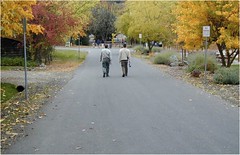
News
By Stefanie Seskin, July 29, 2010
 By planning, designing, and constructing Complete Streets, communities of all sizes – whether rural hamlets, small towns, or booming metropolises – are able to provide the quality access to jobs, health care, shops, and schools their residents deserve, while also achieving greater economic, environmental, and public health benefits.
By planning, designing, and constructing Complete Streets, communities of all sizes – whether rural hamlets, small towns, or booming metropolises – are able to provide the quality access to jobs, health care, shops, and schools their residents deserve, while also achieving greater economic, environmental, and public health benefits.
Yet, I often hear the misconception that Complete Streets are only for urban areas and the people who live there. This assumption leaves out the nearly 49 million Americans who live outside metropolitan areas – 60% of whom live near small towns of populations under 50,000.
These more rural towns and counties have unique challenges and opportunities. They tend to have higher concentrations of older adults and low-income citizens who risk isolation from community and the economy if their mobility is limited to automobiles alone. Like all communities, they must wrestle with growth demand and the potential for increased traffic and congestion. Implementing a Complete Streets policy is therefore key in maintaining their more rural character and heritage, while also enhancing economic competitiveness and providing more transportation and recreation options to residents.
Applied to the community’s context and needs, Complete Streets will look different in rural communities than they do in more urban counterparts. On roads surrounded by agriculture, the street may be “complete” by simply providing wide shoulders to allow safe bicycling and walking and providing connections to regional trail and public transportation networks. Low-speed roads with on-street parking, well-marked crossings, and sidewalks with accessible curb cuts lining one side of the street may best meet the needs of a residential street while balancing the needs of all potential users.
Complete Streets are important in helping town centers and Main Streets thrive, too, by improving street connectivity and allowing everyone, whether on foot, bike, or public transportation, to reach community focal points. Here, the streetscape may be enhanced with additional plantings, historical streetlights, bicycling lanes, and wider sidewalks. This can help facilitate reinvestment and economic development.
Small towns and rural communities recognize these benefits. One of the best Complete Streets policies in the country comes from Decatur, Georgia, a city of about 18,000 outside Atlanta. In just last month, the towns of Sedro-Woolley, Washington, Festus, Missouri, and Golden, Colorado – all with populations under 20,000 – adopted Complete Streets policies.
 Most counties, whether in a metropolitan area or not, will have a combination of urban and rural areas. Ulster County, in the far reaches of the New York City metropolitan area, is home to a large state forest preserve as well as communities of varying sizes, like Kingston (pop. 23,000) and Woodstock (pop. 6,200). Its 2009 resolution will create Complete Streets in each of these different contexts.
Most counties, whether in a metropolitan area or not, will have a combination of urban and rural areas. Ulster County, in the far reaches of the New York City metropolitan area, is home to a large state forest preserve as well as communities of varying sizes, like Kingston (pop. 23,000) and Woodstock (pop. 6,200). Its 2009 resolution will create Complete Streets in each of these different contexts.
Of course, it’s also beneficial for counties and small towns to adopt Complete Streets policies to ensure a “complete” network of accessible streets for everyone. Roads are built and maintained by state, county, and local agencies, and private developers often build new roads. Each agency must provide their own piece of the puzzle so that one town’s sidewalk doesn’t end abruptly because someone else didn’t build their piece.
Many smaller communities do not control their Main Streets – the state Department of Transportation does – making policies at the state level even more important. Yesterday’s passage of a Complete Streets law in the Michigan legislature, for example, will mean that the over 2.5 million rural Michiganders will begin to see more transportation options.
Opportunities for safe walking and biking and to take public transportation between town centers reinforce strong, livable rural towns and counties. Keep an eye on our website in the coming months as we continue this conversation.
Related News

© 2025 Smart Growth America. All rights reserved
Site By3Lane Marketing








